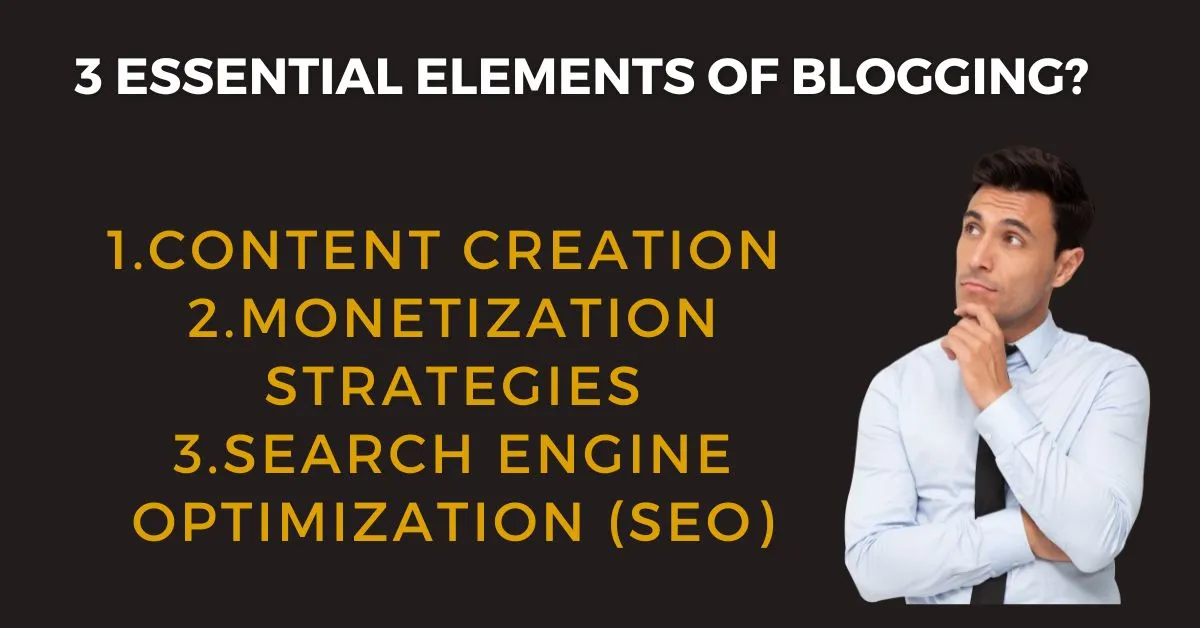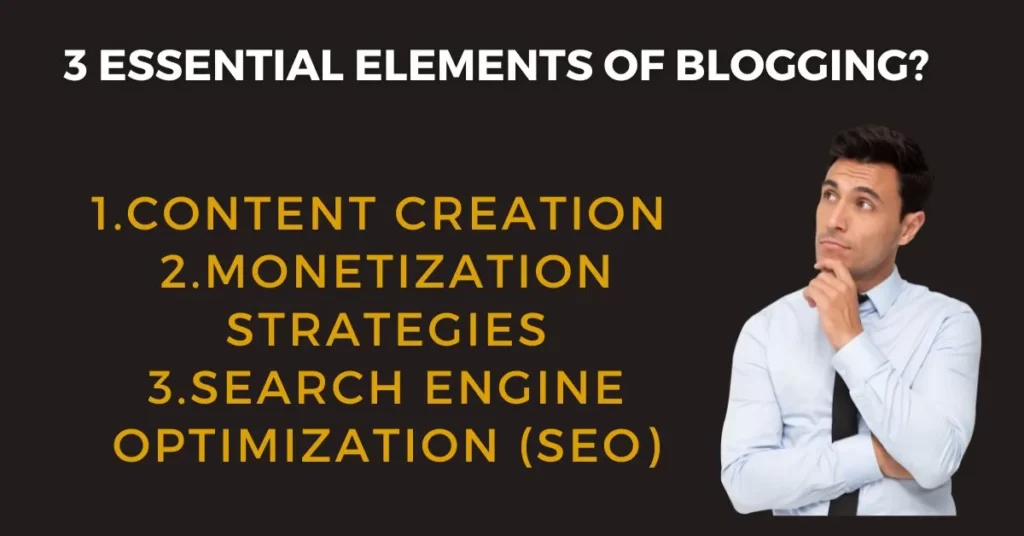
Imagine stepping into a vast library where countless books line the shelves, each waiting to be explored. In the digital realm, blogs serve as the modern equivalent, offering a treasure trove of knowledge, experiences, and perspectives. But what sets apart a captivating blog from a forgettable one? What secret ingredients make readers linger, eagerly devouring every word?
In this journey through the blogosphere, we will unravel what are the 3 essential elements of blogging that transform ordinary blogs into extraordinary literary landscapes. From crafting compelling content to building a community of dedicated followers, these elements hold the power to turn a simple online platform into a captivating and influential realm of ideas.
So, grab your digital notepad and get ready to unlock the secrets of successful blogging!
Table of Contents
Content Creation
The Art of Crafting Compelling Narratives
Content creation is an art form that allows bloggers to unleash their creativity and captivate their audience through compelling narratives. By crafting engaging stories, bloggers can evoke emotions, spark curiosity, and build a strong connection with their readers. Through the power of storytelling, bloggers can make their content memorable and leave a lasting impact.
Understanding the Pulse of the Audience
Successful bloggers have a deep understanding of their audience’s desires, challenges, and aspirations. They delve into market research, conduct surveys, and analyze data to gain insights into their target audience. By empathizing with their readers, bloggers can create content that resonates, addresses their pain points, and provides practical solutions.
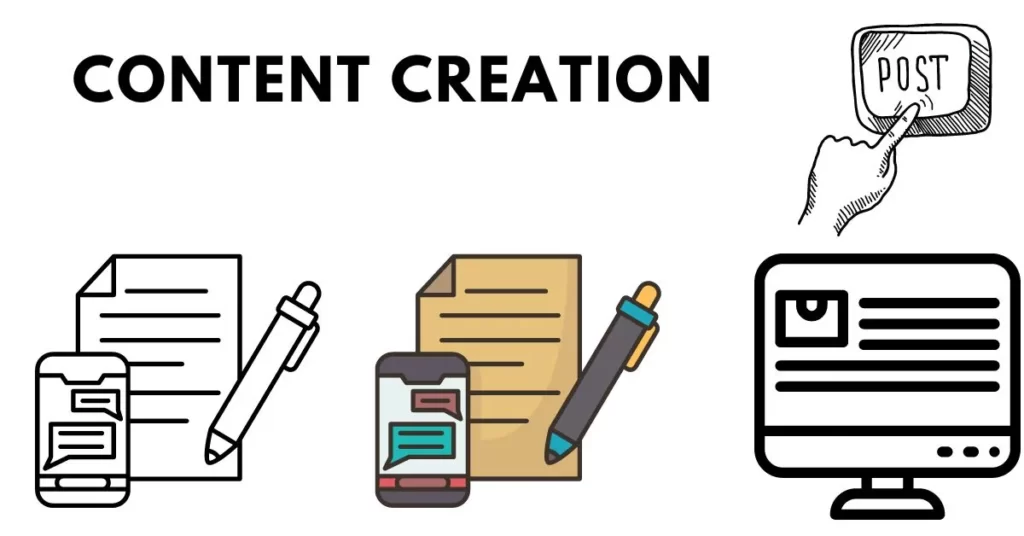
The Artistry of Headline Crafting
Bloggers hold the keys to unlocking curiosity and enticing readers through well-crafted headlines. A captivating headline is like a doorway that beckons readers to step inside the blog post. It should be concise, intriguing, and promise value. Skillful headline creation involves a blend of creativity, wit, and an understanding of the readers’ interests.
Mastering the Flow of Information
A well-structured blog post is akin to a well-orchestrated symphony, guiding readers seamlessly from one idea to another. Bloggers should employ logical flow and organization techniques to present information in a coherent and reader-friendly manner. Clear headings, subheadings, and transitions ensure that readers can easily navigate and digest the content.
Unleashing the Visual Impact
The power of visual elements in blog posts cannot be underestimated. Bloggers have the opportunity to leverage captivating images, informative infographics, and engaging videos to enhance their content’s visual appeal.
Visual elements not only break the monotony of text but also aid in conveying complex ideas, reinforcing key points, and keeping readers visually engaged.
The Science of Search Engine Brilliance
Behind every successful blog post lies a solid understanding of search engine optimization (SEO). Bloggers need to conduct keyword research, strategically incorporate keywords into their content, and optimize meta tags to improve their blog’s visibility in search engine results.
By adhering to SEO best practices, bloggers can ensure their content reaches a wider audience organically. Embracing the art and science of content creation, bloggers can elevate their craft, engage their audience on a deeper level, and leave an indelible impression in the vast realm of the blogosphere.
Audience Engagement
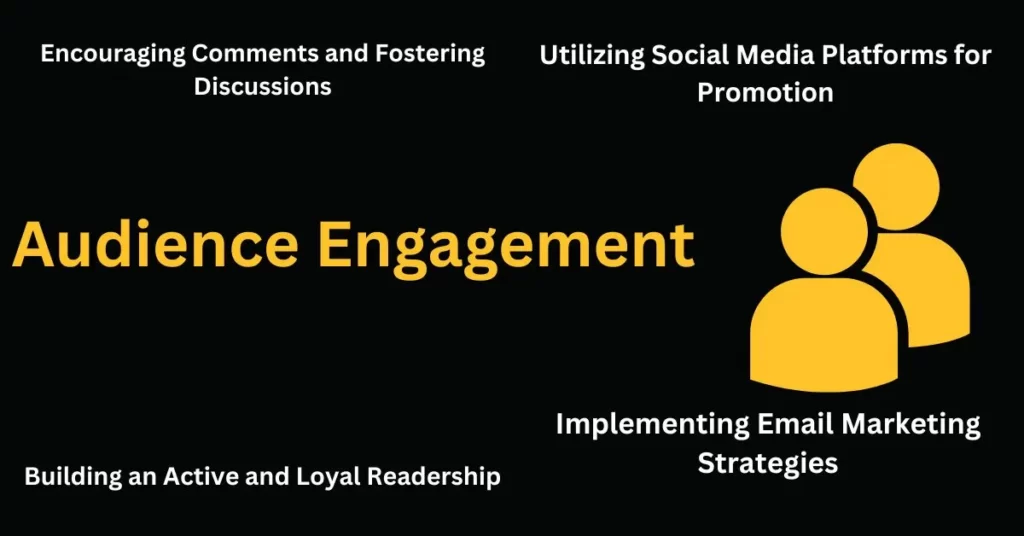
Building an Active and Loyal Readership
One of the fundamental elements of successful blogging lies in cultivating an active and loyal readership. It’s not just about attracting visitors to your blog; it’s about creating a sense of community and establishing a dedicated following.
To achieve this, you must consistently deliver high-quality, relevant, and engaging content that resonates with your target audience. By understanding their interests, needs, and preferences, you can tailor your blog posts to capture their attention and keep them coming back for more.
Encouraging Comments and Fostering Discussions
An interactive and dynamic blog is not complete without active reader engagement. Encourage your audience to leave comments, ask questions, and share their thoughts on your blog posts.
Respond promptly and thoughtfully to each comment, fostering a welcoming and inclusive environment that encourages further discussion. By actively participating in these conversations, you can build a deeper connection with your readers and establish yourself as an approachable and knowledgeable authority in your niche.
Responding to Reader Feedback and Comments
Engagement doesn’t stop at simply replying to comments. It’s crucial to actively listen to your readers and take their feedback into account. By acknowledging their suggestions, addressing concerns, and incorporating their ideas into future content, you demonstrate that their opinions matter and that you value their input.
This strengthens your relationship with your audience and helps you refine your blogging approach to meet their needs and expectations better.
In today’s interconnected world, social media platforms serve as powerful tools for promoting your blog and expanding your reach. Leverage platforms like Facebook, Twitter, Instagram, and LinkedIn to share your blog posts, engage with your audience, and attract new readers.
Craft enticing teasers, utilize relevant hashtags, and encourage social sharing to maximize the visibility of your content. Engage with your followers on social media, responding to their comments and fostering meaningful conversations that drive traffic back to your blog.
Implementing Email Marketing Strategies
Email marketing remains a tried-and-true method for nurturing and retaining your blog’s audience. Offer a newsletter subscription on your blog, providing exclusive content, updates, and valuable insights to your subscribers.
Use email automation tools to send personalized messages, recommend relevant blog posts, and notify subscribers about new content. By building an email list and consistently delivering valuable content to your subscribers’ inboxes, you can strengthen your relationship with your audience and keep them engaged with your blog.
Collaborating with Other Bloggers or Influencers
Collaboration is a powerful way to expand your blog’s reach, tap into new audiences, and foster mutually beneficial relationships. Seek opportunities to collaborate with other bloggers or influencers in your niche by guest posting on each other’s blogs, co-creating content, or participating in joint projects.
By combining your expertise, resources, and networks, you can create a synergy that benefits both parties and exposes your blog to a wider audience. Collaborations not only bring fresh perspectives to your blog but also provide opportunities for cross-promotion and community-building.
Monetization Strategies
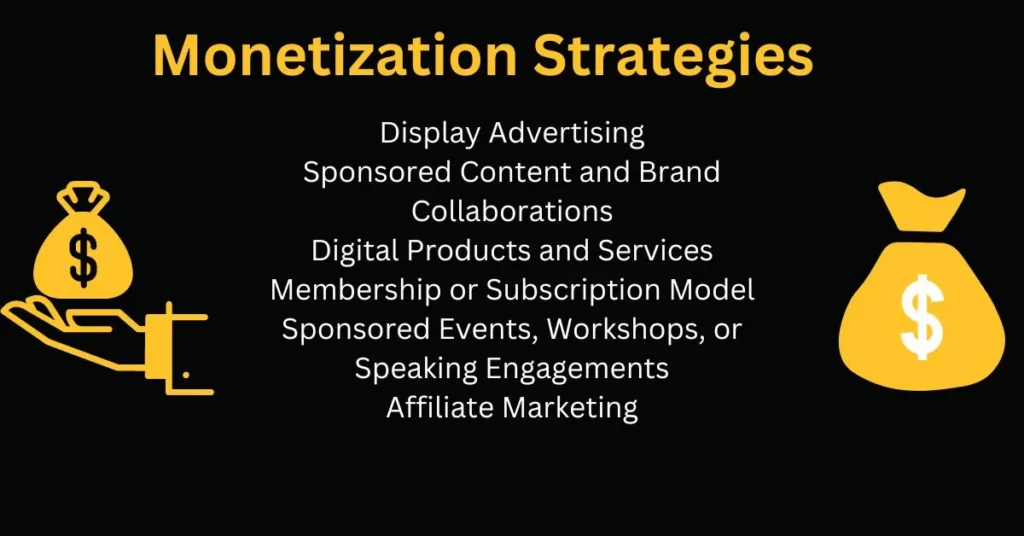
While blogging is often driven by passion and the desire to share knowledge, it can also serve as a viable source of income. Monetizing your blog allows you to turn your passion into a sustainable business or generate additional revenue. In this section, we will explore various strategies and avenues for monetizing your blog effectively.
EXPLORE 4 WAYS TO MONETIZE YOUR BLOG
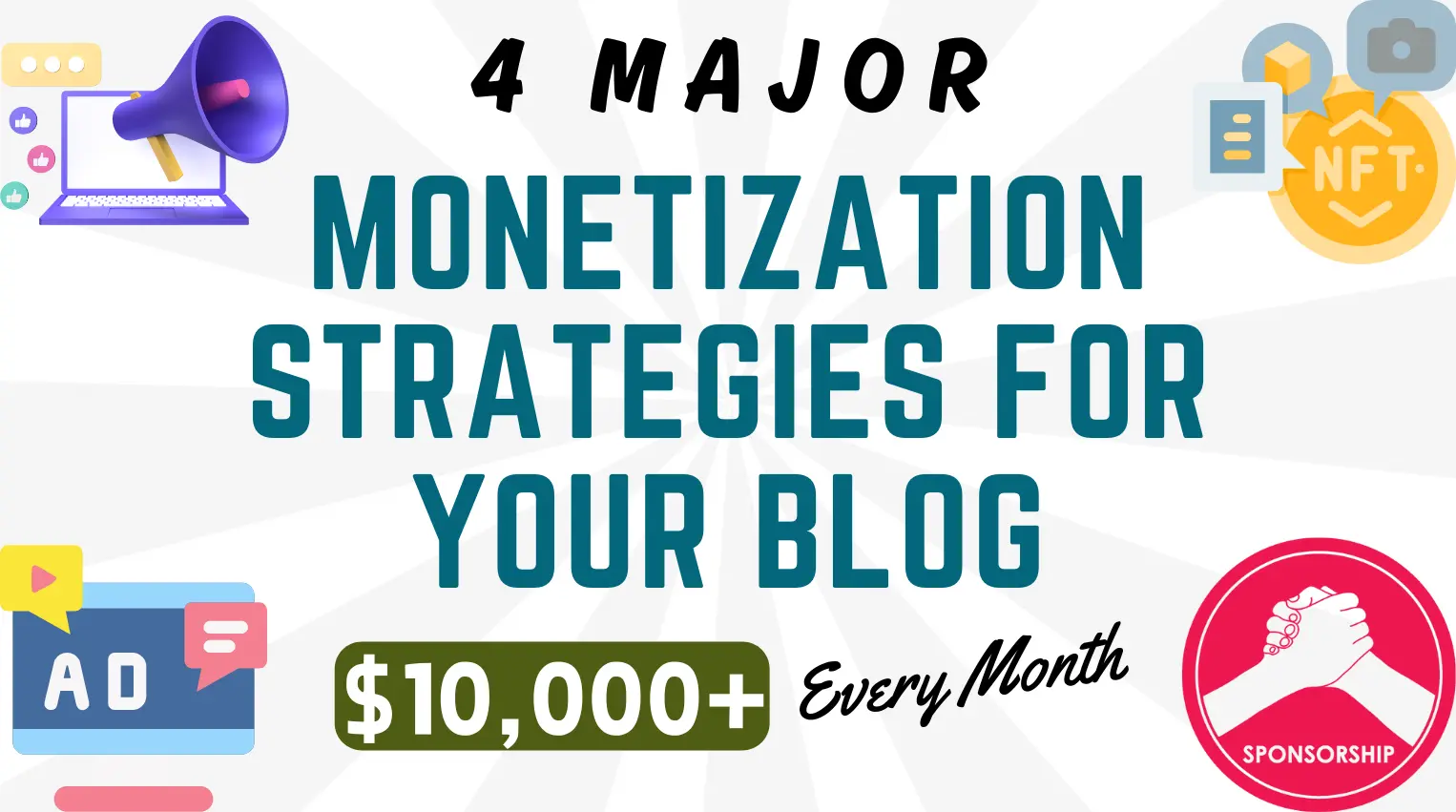
Display Advertising
One of the most common monetization methods for bloggers is display advertising. By joining an advertising network like Google AdSense, you can display ads on your blog, earning revenue when visitors click on or view those ads.
Strategic ad placement, understanding your audience’s preferences, and optimizing your blog’s design can maximize ad performance and increase your earnings.
Affiliate Marketing
Affiliate marketing offers a way to earn commissions by promoting products or services on your blog. You can partner with relevant companies or join affiliate networks to access a wide range of products to recommend to your audience.
EXPLORE STEP-BY-STEP GUIDE: How to start an affiliate marketing as a beginner? 6 EASY STEPS
When readers make a purchase through your unique affiliate links, you earn a percentage of the sale. Selecting products that align with your blog’s niche and genuinely providing value through honest recommendations is crucial for building trust with your audience.
Sponsored Content and Brand Collaborations
As your blog grows, you may attract the attention of brands or businesses seeking exposure to your audience. Sponsored content and brand collaborations involve partnering with companies to create content that promotes their products or services.
This can take the form of sponsored blog posts, product reviews, or social media endorsements. It is essential to maintain transparency and ensure that sponsored content aligns with your blog’s values and provides genuine value to your readers.
Digital Products and Services
Another monetization avenue is creating and selling digital products or services. These can include e-books, online courses, consulting services, or premium content subscriptions.
By leveraging your expertise and catering to the specific needs of your audience, you can create valuable resources that readers are willing to pay for. Digital products and services provide an opportunity for additional income while establishing yourself as an authority in your niche.
Membership or Subscription Model
If you consistently produce high-quality, exclusive content, implementing a membership or subscription model can be a lucrative monetization strategy.
By offering premium content, access to a private community, or additional perks to paying members, you can generate recurring revenue and foster a sense of exclusivity. This model works best when you have a dedicated and engaged audience willing to invest in your blog’s unique offerings.
Sponsored Events, Workshops, or Speaking Engagements
As your influence and expertise grow, you may have opportunities to monetize your blog through sponsored events, workshops, or speaking engagements. Brands or organizations might sponsor or invite you to speak at conferences, workshops, or industry events, providing you with exposure, compensation, or networking opportunities. These opportunities not only contribute to your income but also enhance your credibility and expand your professional network.
Remember, while monetization is essential, maintaining the integrity and trust of your audience should always be a priority. Strive to strike a balance between monetization strategies and delivering valuable, authentic content that keeps your readers engaged and coming back for more.
Search Engine Optimization (SEO)
In the vast digital landscape, where countless blogs compete for attention, it’s crucial to implement effective search engine optimization (SEO) strategies to increase your blog’s visibility and attract organic traffic. In this section, we will explore the essential elements of SEO that can propel your blog to the top of search engine rankings.
Understanding the Basics of SEO
To navigate the complex world of SEO, it’s essential to grasp the fundamental concepts. Understand how search engines work, the importance of keywords, and the significance of factors like user experience, relevance, and authority. By familiarizing yourself with the basics, you can lay a solid foundation for optimizing your blog for search engines.

Conducting Keyword Research
Keywords act as the bridge between your blog and search engine users. Conduct thorough keyword research to identify the terms and phrases your target audience is searching for.
Tools like Google Keyword Planner, SEMrush, or Moz Keyword Explorer can help you discover relevant keywords with sufficient search volume and manageable competition. By incorporating these keywords strategically into your content, you increase the chances of ranking higher in search engine results.
Optimizing Blog Posts for Target Keywords
Once you’ve identified your target keywords, it’s time to optimize your blog posts accordingly. Optimize your title tags, meta descriptions, and headings to include relevant keywords naturally. Ensure that your content is well-structured, easy to read, and provides valuable information to readers.
Incorporate keywords into the body of your blog posts while maintaining a natural flow. Additionally, optimize images by adding descriptive alt tags and compressing file sizes to improve page loading speed.
Improving Website Speed and Performance
Website speed and performance play a vital role in both user experience and SEO. Optimizing your blog’s loading speed is crucial as slow-loading pages can lead to higher bounce rates and lower search engine rankings.
Compress images, minify CSS and JavaScript files, leverage browser caching, and choose a reliable hosting provider to enhance your website’s speed. Conduct regular performance audits to identify and address any issues that may hinder your blog’s performance.
Building High-Quality Backlinks
Backlinks, also known as inbound links, are links from other websites that point to your blog. Search engines consider backlinks as a vote of confidence and authority for your content. Focus on building high-quality backlinks from reputable websites in your niche.
Guest posting, collaborating with influencers or other bloggers, and participating in industry forums or communities are effective ways to acquire relevant backlinks. The quality, relevance, and diversity of your backlinks can significantly impact your blog’s search engine rankings.
Monitoring and Analyzing Website Traffic
To measure the success of your SEO efforts, it’s crucial to monitor and analyze your website traffic regularly. Utilize tools like Google Analytics or other SEO analytics platforms to gain insights into your blog’s performance.
Track key metrics such as organic search traffic, page views, bounce rates, and conversion rates. Analyze this data to identify trends, understand user behavior, and make data-driven decisions to continually optimize your blog’s SEO strategy.
By implementing these SEO strategies, you can enhance your blog’s visibility, attract targeted organic traffic, and establish a strong online presence. Remember, SEO is an ongoing process that requires continuous monitoring, optimization, and adaptation to stay ahead of the ever-evolving search engine algorithms.
Conclusion on ‘What are the 3 essential elements of blogging?’
In the vast realm of blogging, where countless voices compete for attention, understanding and implementing the three essential elements can set your blog apart from the rest.
Crafting compelling content that resonates with your audience forms the foundation of a successful blog. By consistently delivering high-quality, relevant, and engaging posts, you can build an active and loyal readership that keeps coming back for more.
Engaging with your audience is equally crucial. Encouraging comments, fostering discussions, and responding to reader feedback not only create a sense of community but also establish trust and credibility.
Utilizing social media platforms for promotion and implementing email marketing strategies can further expand your reach and deepen your connection with your audience.
Lastly, monetization strategies can transform your blog from a passion project into a sustainable business. Display advertising, affiliate marketing, sponsored content, digital products, and services, membership models, and collaborations offer avenues for generating income while providing value to your readers.
While these three essential elements lay the foundation for a successful blog, remember that blogging is a journey. Continuously evolving and adapting to the ever-changing digital landscape is critical.
Embrace new strategies, stay updated with the latest trends, and always prioritize delivering valuable content to your readers.
So, armed with the knowledge of these essential elements, go forth and create a blog that captivates, engages, and leaves a lasting impact on your audience. Embrace your unique voice, unleash your creativity, and watch your blog flourish as a valuable platform in the vast blogosphere.

